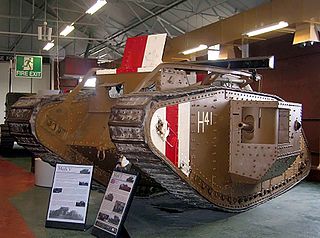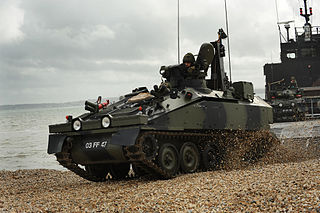
An armoured fighting vehicle or armored fighting vehicle (AFV) is an armed combat vehicle protected by armour, generally combining operational mobility with offensive and defensive capabilities. AFVs can be wheeled or tracked. Examples of AFVs are tanks, armoured cars, assault guns, self-propelled artilleries, infantry fighting vehicles (IFV), and armoured personnel carriers (APC).
The Future Rapid Effect System (FRES) was the name for the British Ministry of Defence (MOD) programme to deliver a fleet of more than 4,000 armoured fighting vehicles for the British Army. The vehicles were to be rapidly deployable, network-enabled, capable of operating across the spectrum of operations, and protected against current threats. The programme has now been split into two separate procurement projects for a reconnaissance Specialist Vehicle (SV) and an aspiration for a future Utility Vehicle (UV). The General Dynamics Ajax was selected to fulfill the SV requirement in 2016.

A flight recorder is an electronic recording device placed in an aircraft for the purpose of facilitating the investigation of aviation accidents and incidents. The device may often be referred to colloquially as a "black box", an outdated name which has become a misnomer—they are now required to be painted bright orange, to aid in their recovery after accidents.
A lynx is a type of wild cat.

The Combat Vehicle Reconnaissance (Tracked), abbreviated CVR(T), is a family of armoured fighting vehicles (AFVs) developed in the 1960s and is in service with the British Army and others throughout the world. They are small, highly mobile, air-transportable armoured vehicles, originally designed to replace the Alvis Saladin armoured car.

The FV101 Scorpion is a British armoured reconnaissance vehicle and light tank. It was the lead vehicle and the fire support type in the Combat Vehicle Reconnaissance (Tracked), CVR(T), family of seven armoured vehicles. Manufactured by Alvis, it was introduced into service with the British Army in 1973 and was withdrawn in 1994. More than 3,000 were produced and used as a reconnaissance vehicle or a light tank.

FV103 Spartan is a tracked armoured personnel carrier. It was developed for the British Army as the APC variant of the Combat Vehicle Reconnaissance (Tracked) family. The vehicle can carry up to seven personnel, including three crew members. Armed with a single machine gun, it is almost indistinguishable from the FV102 Striker in external appearance.

The FV104 Samaritan is the British Army armoured ambulance variant of the CVR(T) family. It has a capacity for up to 6 casualties. It entered service in 1976.

The FV107 Scimitar is an armoured tracked military reconnaissance vehicle formerly used by the British Army, until it was retired from active service in April 2023. It was manufactured by Alvis in Coventry. It is very similar to the FV101 Scorpion, but mounts a high-velocity 30 mm L21 RARDEN cannon instead of a 76 mm gun. It was issued to Royal Armoured Corps armoured regiments in the reconnaissance role. Each regiment originally had a close reconnaissance squadron of five troops, each containing eight FV107 Scimitars. Each Main Battle Tank Regiment also employed eight Scimitars in the close reconnaissance role.

Sabre is a variation of the Combat Vehicle Reconnaissance (Tracked), featuring the turret from a wheeled Fox Armoured Reconnaissance Vehicle mounted on the hull of a tracked FV101 Scorpion.

A draisine is a light auxiliary rail vehicle, driven by service personnel, equipped to transport crew and material necessary for the maintenance of railway infrastructure.

The Alvis Stormer is a military armoured vehicle manufactured by the British company Alvis Vickers, now BAE Systems Land & Armaments.
The Formation Reconnaissance Regiment is a fighting unit provided by the Royal Armoured Corps or Household Cavalry.

The FV721 Fox Combat Vehicle Reconnaissance (Wheeled) (CVR(W)) was a 4 × 4 armoured car manufactured by ROF Leeds, deployed by the British Army as a replacement for the Ferret scout car and the Saladin armoured car. The Fox was introduced into service with B Squadron, 1st Royal Tank Regiment (Aliwal Barracks, Tidworth) in 1975 and withdrawn from service 1993–94.

The L21A1 RARDEN is a British 30 mm autocannon used as a combat vehicle weapon. The Royal Armament Research and Development Establishment (RARDE) and the Royal Small Arms Factory (RSAF), were part of the Ministry of Defence, at the time.
Mayday—alternatively known as Air Crash Investigation(s) in Australia (Seven Network), New Zealand, South Africa, and the United Kingdom; alternatively known as Air Crash: Disaster Revealed on 5Select and some Asian and European countries; and additionally known as Air Emergency, Air Disasters, and Mayday: Air Disaster in the United States—is a Canadian documentary television program examining air crashes, near-crashes, hijackings, bombings, and other disasters. Mayday uses re-enactments and computer-generated imagery to reconstruct the sequence of events leading up to each disaster. In addition, survivors, aviation experts, retired pilots, and crash investigators are interviewed, to explain how the emergencies came about, how they were investigated, and how they might have been prevented.
The 8th Reconnaissance Regiment , commonly abbreviated to 8 Recce, VIII Recce or 8 Canadian Recce, was the reconnaissance arm of the 2nd Canadian Infantry Division during World War II. The core of the regiment was formed from the militia unit the 14th Canadian Hussars.

The Combat Reconnaissance Vehicle (Wheeled), abbreviated to CVR(W), was a line of vehicles to replace the Ferret Armoured Car in British Army service.

Armoured reconnaissance is the combination of terrestrial reconnaissance with armoured warfare by soldiers using tanks and wheeled or tracked armoured reconnaissance vehicles. While the mission of reconnaissance is to gather intelligence about the enemy with the use of reconnaissance vehicles, armoured reconnaissance adds the ability to fight for information, and to have an effect on and to shape the enemy through the performance of traditional armoured tasks.
The Mechanised Infantry Vehicle (MIV) is the British Army's concept of an 8 × 8 wheeled vehicle. In March 2018 the United Kingdom rejoined the Boxer programme in order to move to an assessment phase, which may see the Boxer selected.













